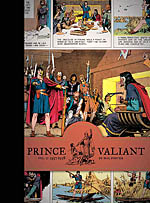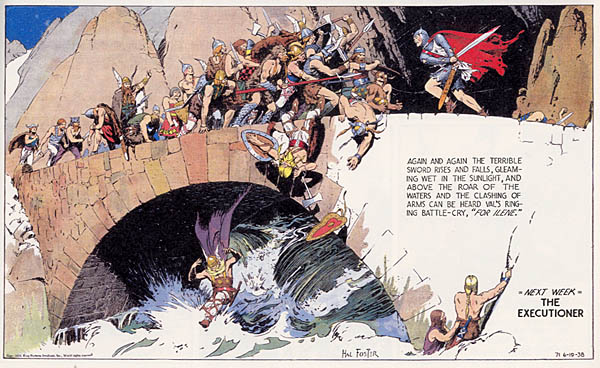 By Hal Foster
By Hal Foster
120 pages, color
Published by Fantagraphics Books
"Prince Valiant? Really?" That was more or less the response I got when my boyfriend discovered I’d bought Prince Valiant Vol. 1: 1937-1938. From there, he explained why this was such a bad idea, and what a dull, boring comic it was. And you know something? I understood where he was coming from. I remember Prince Valiant strips growing up being an exercise in dullness, like all the serial strips that I didn’t care to follow. But after seeing Dave Gibbons and Ryan Sook pay homage to Prince Valiant in Wednesday Comics #1, well, I just had to give it another shot. As it turns out, it was a good decision.
It was the era of King Arthur, when Prince Valiant and his family came to England. Forced out of their kingdom of Thule by an usurper, life at first looked to be little more than exile in the fens of England. But as Prince Valiant leaves the wetlands for adventure, he finds himself in the midst of just that. Before long he’s a squire at King Arthur’s court and has fallen in love with the woman of his dreams—but will a swamp witch’s curse doom him for all eternity?

I’ll admit that reading the first few pages of Prince Valiant, I was wondering if I’d made the right decision. It’s a slow, in media res start, with Valiant and his family arriving in England and fighting their way towards a new home. Once they get settled, though, it’s as if Foster had felt it was time to get things rolling in his new comic strip. That’s when we start getting journeys into the swamp, and then even better, journeys outside of the swamp and mixing it up with King Arthur and his men. Prince Valiant as a squire to Sir Gawain is the moment when the strip has truly arrived, having a surprisingly high amount of plot advancement for just a single broadsheet page of comic. There’s a nice level of cheek about the strip, like when Valiant and Gawain free themselves from a Baron’s prison and then spend the day in the Baron’s quarters while their captor is now the prisoner, tied up in the back of the room as Valiant and Gawain enjoy all the luxuries that belong to the Baron. What surprised me the most, though, was that by the end of this first volume (almost two full years worth of strips), how much Foster had brought me to care about these characters. The "all told in narration" format actually works well towards this, because it uses the expressive nature of prose to bring across additional material that might have otherwise taken longer to fully bring across to the reader.

This new edition of Prince Valiant is primarily scanned directly from a collection of artist’s proofs that had belonged to Foster himself. The end result is that perhaps for the first time ever, we’re able to see just how detailed and elaborate Foster’s art really was. The number of fine lines that went into each drawing is impressive, providing a fine texture and grace to every single panel. More importantly, though, was how well Foster set up his pages. His layouts draw the reader across the page from one panel to the next, often culminating in a truly impressive final panel. One of my favorite moments is when Val has to go up against an entire army, using a bridge as his point of no return. The number of enemies grows in mass as your eye moves to the right, turning into a virtual horde that crashes up against Val like a massive wave in the ocean. As the villains spill off the bridge and into the water, you can almost see them actually tumble, there’s such a strong sense of motion.
I’ve seen the error of my ways, and once you read Prince Valiant Vol. 1: 1937-1938, I suspect you will too. As an added bonus, because Prince Valiant began in February 1937, the pages that would have been used for the earliest part of that year are taken up by a rare interview with Foster, an essay on Prince Valiant by comics historian Brian M. Kane, and a piece explaining the different art sources for reprints over the years and the differences in quality. Prince Valiant was good all along. Who knew?
Purchase Links: Amazon.com | Powell’s Books
